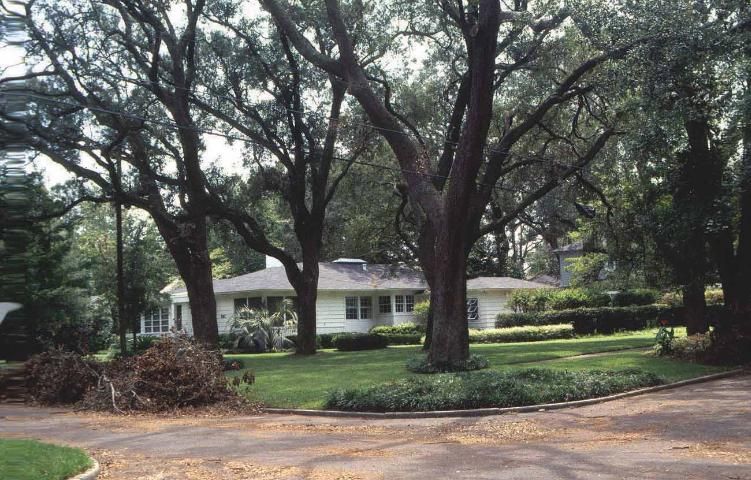
Wind damage to urban trees increases with storm intensity, but not all tree species withstand high winds to the same degree, making some trees better choices than others for including in coastal landscapes. A team of scientists at the University of Florida/Institute of Food and Agricultural Sciences (UF/IFAS) studied 10 hurricanes to determine their effect on the urban forest. One of the major goals of this study was to assemble lists of relative wind resistance for different urban tree species to help communities better prepare for future hurricane seasons by selecting proper species. (Chapter 9 reports on tropical and subtropical tree species). This fact sheet presents the research and methodology that lead to these lists of relative wind resistance. It also discusses in detail the results and additional recommendations for selecting and establishing trees for a healthier and more wind-resistant urban forest.
The Study
In 2004, four hurricanes struck Florida with maximum sustained winds ranging from 169 to 233 km/h (105 to 145 mph). In 2005, Hurricane Dennis struck the Florida panhandle at 193 km/h (120 mph). The impacts of these five hurricanes were widespread. They affected urban areas, agricultural croplands, and Florida's natural ecosystems (Duryea et al. 2007). Since 1992 when Hurricane Andrew struck south Florida, we have been studying the impacts of hurricanes on the urban forest (Duryea et al. 1996). We continued with measurements of hurricane wind damage to urban neighborhoods again in 1995 when two hurricanes struck the Pensacola area (Duryea 1997) and then again in 1998 when Hurricane Georges crossed over the entire island of Puerto Rico. These nine hurricanes with their varied wind speeds gave us the opportunity to study over eighty tree species and their comparable responses to hurricanes. This study reports on the relative wind resistance of southeastern coastal plain species in urban forests (including plant hardiness zones 8 and 9).
Methods
Urban Tree Damage Measurements
Urban tree damage was measured within three to six days following each hurricane that struck the Florida panhandle: Erin, Opal, Ivan, and Dennis (Figure 1). We also report the hurricane response of coastal plain species such as live oak (Quercus virginiana) and sabal palm (Sabal palmetto) that occur throughout Florida and were impacted by Hurricanes Andrew, Charley, Frances, and Jeanne. Hurricane Andrew results were collected in a survey of 128 homeowners in Dade County, Florida who reported the impacts of the hurricane on trees in their yards (Duryea et al. 1996). The methodology for the other eight hurricanes was the same and was as follows. Neighborhoods at the point of landfall of the hurricane were randomly chosen on the strong side of the storm. For each neighborhood, all trees in front yards were observed along street transects. (If invited, we also measured trees in backyards.) Overall we sampled 100 neighborhoods and 18,200 trees. Each tree's diameter at breast height (for dicots and conifers) or height (for palms) was measured (estimated for height), and then it was determined if the tree was standing, leaning or had fallen. Leaning trees were those that were leaning as a result of the storm at less than a 45 degree angle. Fallen trees were either broken at the main stem or lying on the ground. All fallen trees were assessed as either broken or uprooted. Percent survival was calculated for each species using trees that were standing after the hurricane (Trees were considered not surviving if they had fallen or if they were leaning at less than a 45 degree angle.)
Crowns of all standing trees were first assessed for percent branch loss and then for leaf loss from the hurricane. For palms, only percent leaf loss was assessed. Then for dicots and conifers, if a tree had 50% or greater branch loss from the hurricane, it was declared dead and a new second survival percentage was calculated. This is called the "recalculated survival" throughout this document.
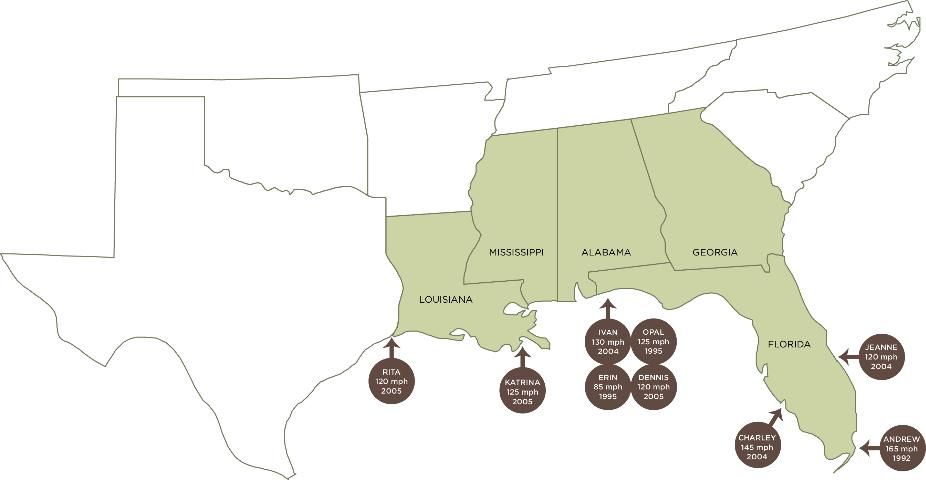

The Survey
After four hurricanes struck Florida in 2004, we concluded that urban forest professionals in the state were a resource of knowledge about wind resistance. In June 2005, we sent out 240 surveys to arborists, urban foresters, and forest scientists who were members of the International Society of Arboriculture (Florida chapter) or the Florida Urban Forestry Council or who were faculty at the University of Florida. We asked them to rank the wind resistance (high, medium, or low) of those urban tree species they observed after hurricanes. Eighty-five (85) surveys (35%) were returned. We report these numbers and percentages in this publication and then use these ratings along with our measurements and analyses and the scientific literature to formulate wind resistance lists for tree species in urban areas.
Results
Tree Survival and Branch Loss
Tree species in the Southeastern Coastal Plain respond differently to hurricanes. Response of species to Hurricane Ivan in 2004 illustrates differences at 209 km/h (130 mph) wind speeds (Figure 2). Tree species demonstrating the highest survival in these winds were sand live oak (Quercus geminata), American holly (Ilex opaca), southern magnolia (Magnolia grandiflora), live oak, wax myrtle (Myrica cerifera), sweetgum (Liquidambar styraciflua), crape myrtle (Lagerstroemia indica), dogwood (Cornus florida), and sabal palm. Dogwood, live oak, sabal palm, sand live oak, and southern magnolia were also the best survivors in Hurricanes Erin and Opal in 1995 (Duryea 1997).
A more detailed look at live oak and sabal palm demonstrates their repeated resilience to hurricane-force winds (Table 1). However, it can also be seen that in south Florida when the winds reached 233 and 265 km/h (145 and 165 mph) in Hurricanes Charley and Andrew, survival of live oak decreased to 78%.
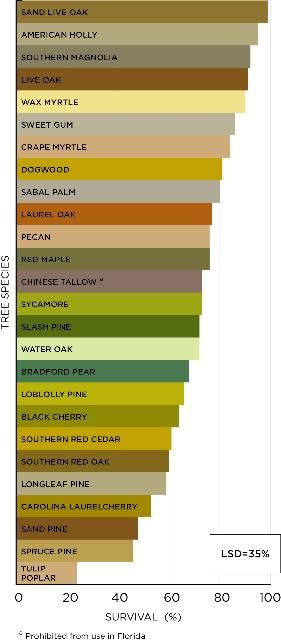
In a statistical comparison of sand live oak, live oak, and laurel oak, laurel oak had poorer overall survival than both live oak and sand live oak in four panhandle Florida hurricanes (p<0.001) (Figure 3). In several publications, live oak, sabal palm, baldcypress (Taxodium distichum) and pondcypress (Taxodium ascendens) have been ranked at the top of lists for hurricane-related wind resistance (Touliatos and Roth 1971; Swain 1979; Barry et al. 1993).
Branch loss in hurricanes may also be an important measure of trees' resilience (Figure 4). In Hurricane Ivan, southern red cedar (Juniperus virginiana var. silicicola), sycamore (Platanus occidentalis), southern red oak (Quercus falcata), and laurel oak lost on average over 25% of their branches. Sweetgum, silver maple (Acer saccharinum), sycamore, and southern red cedar were species losing the most branches in Hurricanes Erin and Opal (Duryea 1997). Species with 10% or less branch loss were crape myrtle, loblolly pine (Pinus taeda), American holly, and tulip poplar (Liriodendron tulipifera).
When we looked at tree diameter and branch loss, we found that large trees (100-200 cm, 39-79 in diameter) lost the most branches (30%), followed by medium sized trees (50-99 cm, 20-39 in) with 25% loss, smaller trees (20-49 cm, 8-19 in) with 20% loss, and finally the smallest trees (< 20 cm, 8 in), which lost 12% of their branches (p<0.0001). Glizenstein and Harcombe (1988) also found that damage was positively correlated with average stem size in a forest stand. In their review, Everham and Brokaw (1996) summarize that most researchers have found a positive correlation between stem size and wind damage. Webb (1989) found that larger trees were more likely to be damaged directly by the wind compared to smaller trees, which were more likely to be indirectly damaged by other falling trees.
Since trees with large amounts of branch loss from a hurricane may not be considered as healthy urban trees, we re-analyzed survival, taking into account branches lost. As mentioned before, standing trees that had 50% or greater branch loss were called dead and a "new" survival was calculated (named "recalculated survival" henceforth) (Figure 5).
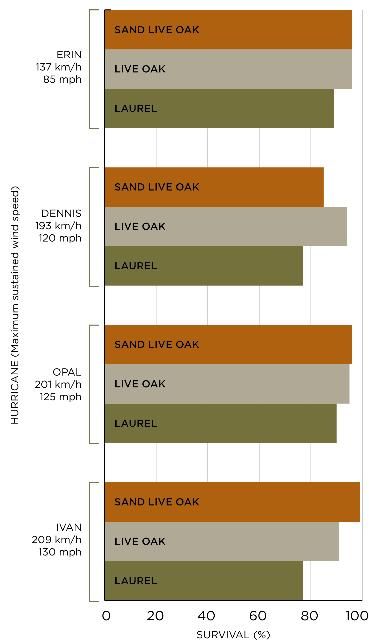
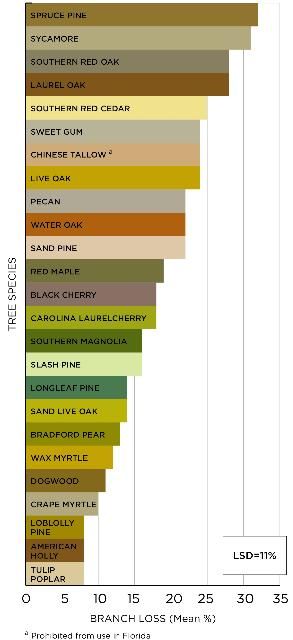
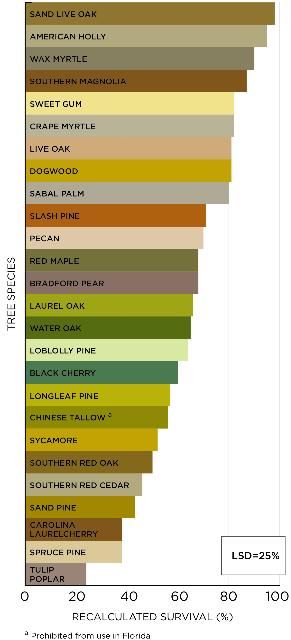
Some species with heavy branch loss had significantly lower recalculated survival. Southern red cedar survival was decreased from 61% to 46% due to heavy branch loss. Sycamore survival was reduced from 73% to 52%. Even live oak trees had significant branch loss, and their survival was decreased from 91% to 81%. When we statistically compared the recalculated survival of oak species after Hurricane Ivan, the ranking from greatest to lowest survival was sand live oak (98% survival), live oak (81%), laurel oak (66%), water oak (Quercus nigra) (65%), and Southern red oak (50%) (p=0.0001). A study in South Carolina coastal plain forests after Hurricane Hugo also found that live oak was less damaged than laurel and water oaks (Gresham et al. 1991).
Survival of pine species showed significant differences with greatest survival for slash pine (Pinus elliottii var. elliottii) (71%), then loblolly (64%), longleaf (Pinus palustris) (57%), sand pine (Pinus clausa) (43%), and spruce pine (Pinus glabra) (38%) (p=0.0014). Three months after Hurricane Ivan, we re-measured pines and found that 2% to 3% of the slash and longleaf standing trees had died and 56% of the standing sand pine had died. In the southeastern coastal plain forest, longleaf pine was less damaged than loblolly during Hurricane Hugo (12% versus 73% damaged) (Gresham et al. 1991), but a tornado in Texas resulted in equal and intense damage to loblolly, longleaf, and shortleaf (Pinus echinata) pines (Glitzenstein and Harcombe 1988). Two conifer species that have shown repeatedly poor performance in our studies during hurricanes are sand pine and southern red cedar (Duryea 1997) (Table 1).
Defoliation
There were distinct species differences in defoliation during Hurricane Ivan. Species like sand live oak, crape myrtle, and dogwood lost an average of 94%, 88%, and 86% of their leaves compared to southern red cedar, wax myrtle, slash pine, longleaf pine, and loblolly pine, which lost 32%, 31%, 29%, 19%, and 11% of their leaves, respectively (lsd=17%) (Figure 6).
Leaf loss had a positive relationship (p<0.0001) with both survival and recalculated survival (trees with = 50% branch loss excluded), which is to say that losing leaves during the hurricane meant higher survival. Francis and Gillespie (1993), reporting on urban trees in Puerto Rico after Hurricane Hugo in 1989, also found that crown damage appeared to be avoided if the crown surface area was reduced quickly with leaf and twig loss during the hurricane. There are some exceptions to defoliation being a strategy for survival; southern magnolia, American holly, and sabal palm are all excellent survivors, but they only lost 43%, 34%, and 27% of their leaves.
Native and Exotic Species
In the coastal plain area, exotic tree species made up 8% of the trees in the urban forest. The major exotic species were crape myrtle, Chinese tallow (Sapium sebiferum)—a prohibited invasive species, camphor tree (Cinnamomum camphora)—an invasive species, Bradford pear (Pyrus calleryana), and palms such as pindo palm (Butia capitata) and Washington fan palm (Washingtonia robusta). As a group, native trees survived the same as exotic trees (73% versus 77%, not significantly different [n.s.]) and lost the same amount of branches (20% versus 15%, n.s.) and leaves (58% versus 60%, n.s.). In contrast, after Hurricane Andrew struck south Florida, native trees survived winds better than non-native trees (Duryea et al. 1996). Other studies have shown trends toward increased wind damage of exotic species in rural plantation forests (King 1945; Everham and Brokaw 1996)
The Survey
Arborists' and urban foresters' ratings of wind resistance for coastal plain species show a strong agreement with our measurements over several hurricanes. Small trees that were awarded high wind-resistance ratings were fringe tree (Chionanthus virginicus), dogwood, persimmon (Diospyros virginiana), myrtle oak (Quercus myrtifolia), sparkleberry (Vaccinium arboretum), and the hollies (Ilex spp.) (Table 2).
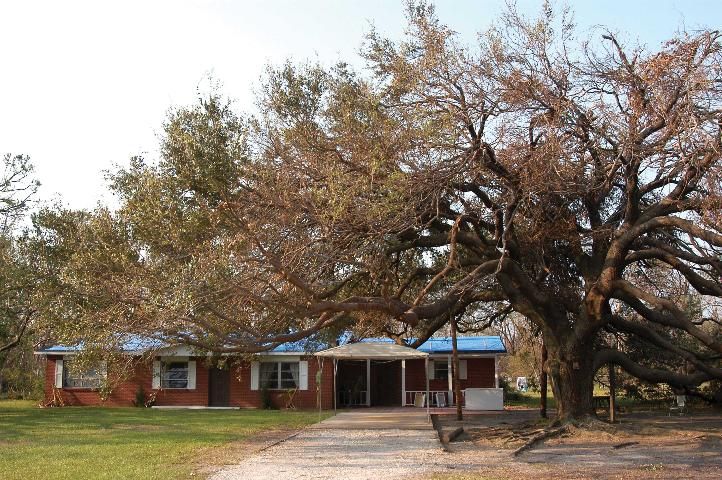
While live oak and sand live oak were rated as high, other oaks such as southern red oak and swamp chestnut oak (Quercus michauxii) were rated as medium, and in agreement with our results, laurel and water oaks were rated as having low wind resistance. Although we have consistently seen low survival or heavy branch damage in southern red cedar, the ratings were even for each of the wind-resistance categories in the survey results. However, 91% of the respondents rated baldcypress and pondcypress with high wind resistance (Figure 7). Both cypresses were stated to have the best wind resistance along with live oak and sabal palm after Hurricanes Camille and Frederick struck the Gulf Coast in 1969 and 1979 (Swain 1979).
In the survey, sand pine received a low rating, which is consistent with our results (Figure 8), while the other pines were mostly rated as medium, again consistent with our results. In their summarizing list of wind resistance for forest species, Everham and Brokaw (1996) cite ten studies where loblolly, slash, and longleaf pines are ranked with low to intermediate wind resistance.
Sabal palm received a high wind resistance rating from 99% of the survey respondents, in agreement with our ratings and those of Swain (1979). Canary Island date palm (Phoenix canariensis), which is being planted more frequently in north Florida, received a high rating from 89% of the respondents (Figure 9).
Respondents rated sweetgum's wind resistance as medium to high; in a summary table of wind resistance by Everham and Brokaw (1996), seven studies rated sweetgum as having medium to high wind resistance. Our studies have shown that it survives well but is prone to some branch breakage. In a Texas study after a tornado, sweetgum was listed as one of the best survivors, but also the tree with the most branch damage (Gliltzenstein and Harcombe 1988). In a study after Hurricane Kate in 1985, sweetgum had low mortality (2%) in a southern mixed hardwood forest compared to spruce pine with 34% mortality (Batista and Platt 2003). They note that wind-firmness of sweetgum is likely due to its underground connections, short and stout branches, and leaves with slender, long petioles that readily detach from branches in wind. On gravelly ridges, hillsides, and upland piedmont sites, sweetgum has been noted to develop a particularly strong taproot and is very resistant to wind (Kormanik 1990).
Tulip poplar had very poor survival in Hurricane Ivan (24%). Survey respondents rated it as having medium to low wind resistance. Everham and Brokaw (1996) summarize two studies in their table with high levels of wind damage for tulip poplar in high intensity storms.
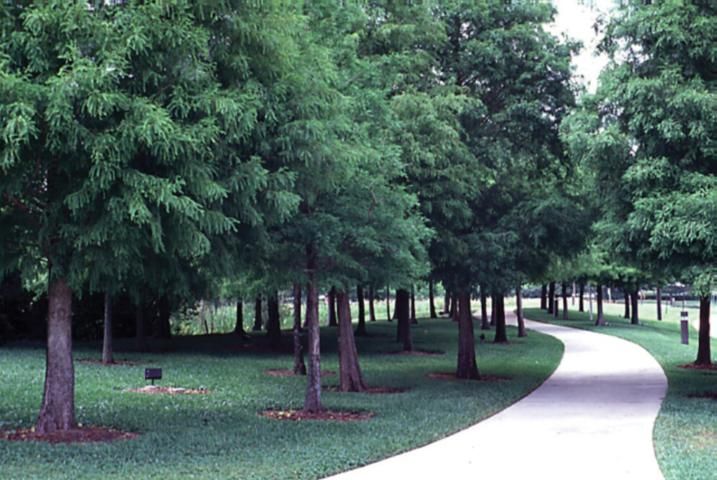
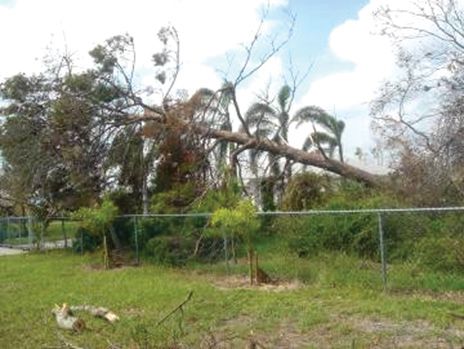
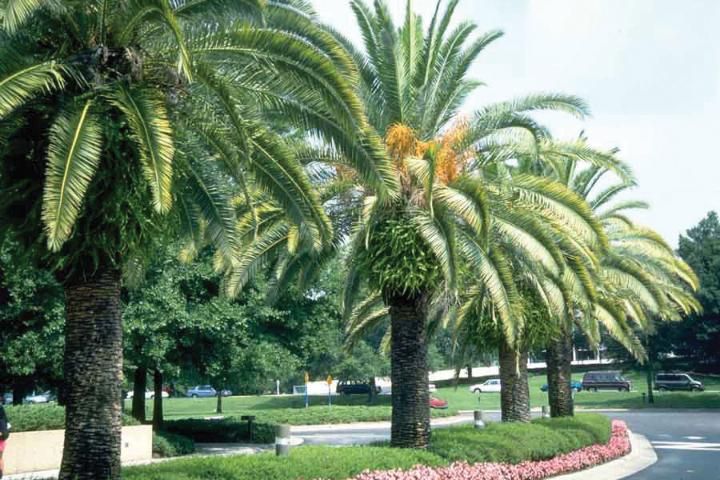
Recommendations
Taking our survival and branch loss results from hurricanes and incorporating results from the survey and from the scientific literature, we have developed lists of relative wind resistance for tree species in the southeastern coastal plain (Table 3). These lists should be used with caution, with the knowledge that no species and no tree is completely wind proof. In addition, local considerations such as soil, cultural practices, tree age and health, and other urban forest health conditions need to be taken into account. In addition to hurricane wind speed, other conditions accompanying hurricanes such as precipitation and the speed with which the storms move through an area appear to influence tree response.
Literature Cited
Barry, P.J., C. Doggett, R.L. Anderson, and K.M. Swain, Sr. 1993. "How to evaluate and manage storm-damaged forest areas". Management Bulletin R8-MB 63 of the USDA Forest Service, Southern Region. Atlanta, GA. 11 pp.
Batista, W.B. and W.J. Platt. 2003. "Tree population responses to hurricane disturbance: syndromes in a south-eastern USA old-growth forest". Ecology 91:197–212.
Duryea, M.L., G.M. Blakeslee, W.G. Hubbard, and R.A. Vasquez. 1996. "Wind and trees: A survey of homeowners after Hurricane Andrew". J. Arboric. 22(1):44–50.
Duryea, M.L. 1997. "Wind and trees: Surveys of tree damage in the Florida Panhandle after Hurricanes Erin and Opal". Circular 1183. UF/IFAS Extension. Gainesville, FL. 7 pp.
Duryea, M.L., E. Kampf, and R.C. Littell. 2007. "Hurricanes and the Urban Forest: I. Effects on Southeastern U.S. Coastal Plain Tree Species". Arboric. & Urban Forestry 33(2):83–97.
Everham III, E.M. and N.V.L. Brokaw. 1996. "Forest damage and recovery from catastrophic wind". The Botanical Review 62:113–185.
Francis, J.K. and A.J.R. Gillespie. 1993. "Relating gust speed to tree damage in Hurricane Hugo", 1989. J. Arboric. 19:368–372.
Glitzenstein, J.S. and P.A. Harcombe. 1988. Effects of the December 1983 tornado on forest vegetation of the Big Thicket, southeast Texas, USA. For. Ecol. Managem. 25:269–290.
Gresham, C.A., T.M. Williams, and D.J. Lipscomb. 1991. Hurricane Hugo wind damage to Southeastern U.S. coastal forest tree species. Biotropica 23(4) (Part A. Special Issue: Ecosystem, Plant, and Animal Responses to Hurricanes in the Caribbean):420–426.
King, H.C. 1945. Notes on the three cyclones in Mauritius in 1945: Their effect on exotic plantations, indigenous forest and on some timber buildings. Empire Forest. J. 24: 192–195.
Kormanik, P. 1990. Liquidambar styraciflua, sweetgum. In: Silvics of North America: 2. Hardwoods. Burns, R. M., and B. H. Honkala, Tech. Coords. (http://www.na.fs.fed.us/spfo/pubs/silvics_manual/table_of_contents.htm) Agriculture Handbook 654 Vol. 2 of the U.S.D.A. Forest Service, Washington, DC. 877 pp.
Swain, K.M. 1979. Minimizing timber damage from hurricanes. S. Lumberman 239:107–109.
Touliatos, P. and E. Roth. 1971. Hurricanes and trees: Ten lessons from Camille. J. For. 285–289.
University of Florida, Institute of Food and Agricultural Sciences. 2018. "Assessment of Non-native Plants in Florida's Natural Areas" (https://assessment.ifas.ufl.edu, 4/29/2019) Gainesville, FL, 32611-4000, USA.
Webb, S.L. 1989. Contrasting windstorm consequences in two forests, Itasca State Park, Minnesota. Ecology 70(4):1167–1180.